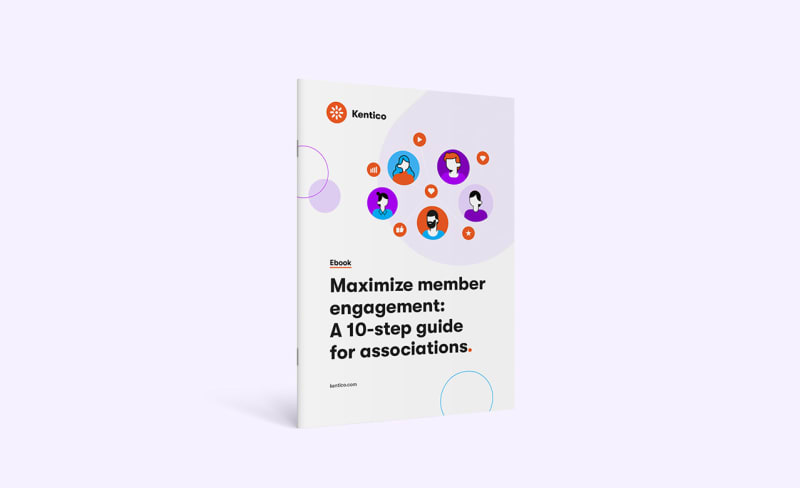The digital landscape moves fast. And while it sweeps our members along for the ride, it often leaves membership organizations and associations scrambling to catch up. In this blog, discover how to keep up with your members’ expectations, create incredible digital experiences that engage and retain, and why understanding your digital maturity is so important.
In recent years, the pace of digital transformation has accelerated dramatically, reshaping how we buy, communicate, and engage. Membership organizations have had to quickly adapt to evolving member needs and behaviors, embracing digital solutions as an essential part of their strategy.
Independent professional network MemberWise recently published its Digital Excellence (2021/22) Report exploring the state of digital in the membership space. It found that despite 95% of organizations agreeing that members today expect an “interactive, engaging, and value-driven online experience,” a mere 35% have a digital strategy in place, and only 25% have a data strategy. Less than half are using automation tools for key tasks, which is unsurprising when a whopping 58% are using bespoke (legacy) CMS systems.
Member engagement and retention should be every association’s top priority. In a truly digital world, where your members are used to companies bending over backwards to deliver exceptional personalized experiences, you can quickly fall below the bar if you don’t know or understand your level of digital experience maturity.
Let’s explore some of the key challenges that membership organizations are facing in this digital-first, digital-now world and why they’re quickly pulling “improve member experiences” forward.
Top challenges membership organizations face today
The membership sector is facing many difficulties, but harnessing the power of digital experience platforms (DXP) can boost their digital maturity to deliver an engaging member journey.
1. Sky-high member expectations: members are used to the VIP treatment they get from the likes of Netflix and Starbucks. They expect their experience to be engaging and interactive, with more media and gamified content, but they also expect it to be tailored to their personal interests and needs. They’re used to a high level of self-service tools and online FAQs so they have more control over their accounts. Many membership organizations simply do not have the systems in place to enable these kinds of experiences.
2. Multichannel requirements: Offline channels are losing effectiveness in the membership world and organizations are recognizing the need to take a cohesive multichannel approach to engagement. However, ensuring consistency across channels and collating member data from across them is easier said than done, especially when relying on disparate systems and siloed data.
3. Unable to optimize journeys: Members want instant gratification: if something takes too long to find or process, they’ll churn. Membership platforms have to be more user-friendly than ever and the technology they’re built on should not get in the way of page speeds.
4. Neglecting retention: Membership organizations often place a lot of emphasis on acquisition, but can suffer from high dropout rates after the first year. You’ll never fill a leaky bucket, so it’s important to ensure that you are also clearly demonstrating the value and benefits of membership to your existing members to improve first-year renewals. Organizations that don’t fully understand their members and why they joined are likely to be fighting a losing battle.
5. Lagging behind data regulations: Keeping your members’ data safe should be a key focus in your digital efforts, however striking the balance between privacy and delivering a personalized experience is more than a little difficult. Without the tools that help ensure compliance, organizations could get themselves into hot water.
6. Measuring ROI: Even membership organizations that have personalization tools at their disposal can find it difficult to successfully measure return on investment. Your analytics capabilities need to be able to clearly show what’s resonating with your audiences across all your efforts and what isn’t. A cross-channel approach is essential to matching a conversion with its journey.
7. Streamlining technology: Labor-intensive and repetitive manual processes for marketers will only slow them down in seizing opportunities and ensuring relevant experiences. Your systems should support your marketers’ self-sufficiency in delivering the kind of experiences that attract, nurture, convert and retain members. A CMS simply won’t cut it.
8. Harnessing the power of AI: Artificial Intelligence (AI) can enhance member engagement through personalized content recommendations, predictive analytics, and automated support, while also offering deeper insights into member behaviors and needs. However, the challenge lies in effectively implementing AI tools that seamlessly integrate with existing systems while ensuring staff are adequately trained to leverage these technologies. Balancing AI's efficiency with the human touch is also crucial, as members still value personal connections.

“Working with autistic people we created ‘calm/vivid’ modes to ensure the site is more accessible for them. And the clear navigation and design allow people to find the information they need and the many different ways they can engage with our charity. We’re already seeing the benefits of user engagement and satisfaction.”
Seven essential strategies for delivering exceptional member experiences
Creating incredible digital experiences is no easy task. Membership organizations need to be taking an outside-in, value-driven, customer-first approach to their acquisition and retention efforts and supporting their digital strategies with robust tools that boost their digital experience maturity. Here’s at least seven ways you can do just that:
1. Deeper member insights: Not fully understanding the needs and motivations of your audience can cause a disconnect between what you think drives intent and why members actually join, leading to low conversion rates and renewals. Only with a 360° view of your members can you accurately tailor messages to resonate as they progress through the membership journey. If your systems can’t talk to one another, then your members’ profiles will be fractured across your website, ecommerce site, mobile apps, event bookings, and social interactions. You’ll never be able to provide a consistent journey, let alone a personalized one.
2. Ease of use for marketers: It’s all very well investing in the biggest and shiniest marketing tools, but can your marketing team actually use them? Marketers should be completely self-sufficient, able to manage, create, and publish content to multiple channels without technical help (and without breaking the website) and to be able to run, automate, test and optimize marketing campaigns by themselves.
3. Optimized email campaigns: Easy-to-use customizable email templates will supercharge your marketing efforts to engage and motivate your members. With marketing automation tools, you’re able to send timely invitations, reminders, and messages to decrease first-year drop out and set up website interactions to trigger on-point email campaigns. Personalization tools will ensure you’re speaking directly to each member, while A/B testing capabilities will enable you to optimize the effectiveness of your emails by helping you identify best performing content. Built-in GDPR compliance takes the pain out of data regulations so you know you’re only contacting those who have opted in. Of course, these tools should all be seamlessly integrated. Better still if they’re all inside one platform.
4. Personalization through segmentation and personas: Using your comprehensive collated member data, you can segment your member base into groups with similar characteristics and serve them with content that will resonate. You could even assign personas to employ a more targeted and tactical approach to engagement to ensure you’re meeting your members ongoing individual needs and continually nurturing them through renewals. With targeted content personalization, you can nurture leads to membership, increase member loyalty, and boost upselling and cross-selling.
5. Member-only zones: Your members want to feel that you care about them—that they are special. Members-only areas provide them with a “home” within your brand and a sense of exclusivity. They’re a great place to offer FAQs and self-service areas and to provide gamified content where you can invite members to earn action-based trophies and rewards.
6. An omnichannel approach: Your members want to be able to engage with your organization through multiple channels and devices, so it’s essential their experience is consistent across them all. They’re already engaging with one another on social sites so there’s a huge opportunity for you to join the conversation. A DXP is designed to enable that coveted consistent member journey across your various member touchpoints.
7. A friction-free customer journey: It’s essential that your technology and processes are supporting your engagement efforts. Easy sign-ins, registrations and payment processes are essential to ensuring a friction-free member experience, as are good page speeds and clear navigation.
These strategies will be essential in delivering exceptional and engaging experiences to your members. However, there is one key element we need to explore that is crucial to understand before making investments in tools and technologies.
Why understanding digital maturity is so important to associations
Digital maturity refers to an organization's ability to effectively use digital tools and technologies to enhance its operations and member interactions. It is not so much a fixed destination as an ongoing journey that involves continuously improving how your organization uses digital tools and technologies to enhance member interactions and internal processes.
For membership organizations and associations, this journey starts with understanding their current level of digital maturity. By assessing how effectively they gather and use data, integrate systems, and personalize member experiences, organizations can identify where they stand and what steps they need to take next. This self-awareness allows them to make informed decisions about which digital tools and strategies to invest in, ensuring they can meet their members' evolving needs and expectations effectively. The goal is to create a flexible digital environment that can adapt quickly to new opportunities and challenges.
Organizations that understand their digital maturity are better equipped to choose and implement the right tools that will help them stay relevant and competitive in a fast-paced digital landscape. A great place to explore your current level of digital maturity is our Digital transformation roadmap, which will give you a clear view of where your organization is at in delivering great member experiences efficiently and effectively and which steps to take next on your digital experience maturity journey.
Have you ever used our Digital Maturity Assessment tool? It's here!
Discover more tips for getting your members engaged with our free ebook, A 10-step guide for maximizing member engagement for associations.
Subscribe to the Kentico Xperience newsletter
You'll receive our newsletter once a month with all the updates you need to know to keep you in the loop with the Kentico Xperience community. Just the hits—guaranteed.


